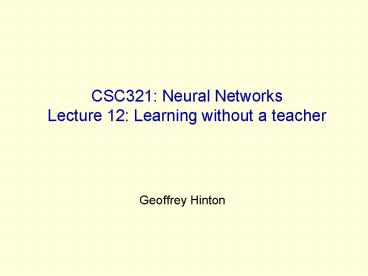CSC321: Neural Networks Lecture 12: Learning without a teacher
Title:
CSC321: Neural Networks Lecture 12: Learning without a teacher
Description:
CSC321: Neural Networks Lecture 12: Learning without a teacher Geoffrey Hinton –
Number of Views:122
Avg rating:3.0/5.0
Title: CSC321: Neural Networks Lecture 12: Learning without a teacher
1
CSC321 Neural NetworksLecture 12 Learning
without a teacher
- Geoffrey Hinton
2
Three problems with backpropagation
- Where does the supervision come from?
- Most data is unlabelled
- The vestibular-ocular reflex is an exception.
- How well does the learning time scale?
- Its is impossible to learn features for different
parts of an image independently if they all use
the same error signal. - Can neurons implement backpropagation?
- Not in the obvious way.
- but getting derivatives from later layers is so
important that evolution may have found a way.
y
w1
w2
3
Three kinds of learning
- Supervised Learning this models p(yx)
- Learn to predict a real valued output or a class
label from an input. - Reinforcement learning this just tries to have a
good time - Choose actions that maximize payoff
- Unsupervised Learning this models p(x)
- Build a causal generative model that explains why
some data vectors occur and not others - or
- Learn an energy function that gives low energy to
data and high energy to non-data - or
- Discover interesting features separate sources
that have been mixed together find temporal
invariants etc. etc.
4
The Goals of Unsupervised Learning
- Without a desired output or reinforcement signal
it is much less obvious what the goal is. - Discover useful structure in large data sets
without requiring a supervisory signal - Create representations that are better for
subsequent supervised or reinforcement learning - Build a density model that can be used to
- Classify by seeing which model likes the test
case data most - Monitor a complex system by noticing improbable
states. - Extract interpretable factors (causes or
constraints) - Improve learning speed for high-dimensional
inputs - Allow features within a layer to learn
independently - Allow multiple layers to be learned greedily.
5
Using backprop for unsupervised learning
- Try to make the output be the same as the input
in a network with a central bottleneck. - The activities of the hidden units in the
bottleneck form an efficient code. - The bottleneck does not have room for redundant
features. - Good for extracting independent features (as in
the family trees)
output vector
code
input vector
6
Self-supervised backprop in a linear network
- If the hidden and output layers are linear, it
will learn hidden units that are a linear
function of the data and minimize the squared
reconstruction error. - This is exactly what Principal Components
Analysis does. - The M hidden units will span the same space as
the first M principal components found by PCA - Their weight vectors may not be orthogonal
- They will tend to have equal variances
7
Principal Components Analysis
- This takes N-dimensional data and finds the M
orthogonal directions in which the data has the
most variance - These M principal directions form a subspace.
- We can represent an N-dimensional datapoint by
its projections onto the M principal directions - This loses all information about where the
datapoint is located in the remaining orthogonal
directions. - We reconstruct by using the mean value (over all
the data) on the N-M directions that are not
represented. - The reconstruction error is the sum over all
these unrepresented directions of the squared
differences from the mean.
8
A picture of PCA with N2 and M1
The red point is represented by the green point.
Our reconstruction of the red point has an
error equal to the squared distance between red
and green points.
First principal component Direction of greatest
variance
9
Self-supervised backprop and clustering
reconstruction
- If we force the hidden unit whose weight vector
is closest to the input vector to have an
activity of 1 and the rest to have activities of
0, we get clustering. - The weight vector of each hidden unit represents
the center of a cluster. - Input vectors are reconstructed as the nearest
cluster center.
data(x,y)
10
Clustering and backpropagation
- We need to tie the input-gthidden weights to be
the same as the hidden-gtoutput weights. - Usually, we cannot backpropagate through binary
hidden units, but in this case the derivatives
for the input-gthidden weights all become zero! - If the winner doesnt change no derivative
- The winner changes when two hidden units give
exactly the same error no derivative - So the only error-derivative is for the output
weights. This derivative pulls the weight vector
of the winning cluster towards the data point.
When the weight vector is at the center of
gravity of a cluster, the derivatives all balance
out because the c. of g. minimizes squared error.
11
A spectrum of representations
- PCA is powerful because it uses distributed
representations but limited because its
representations are linearly related to the data - Autoencoders with more hidden layers are not
limited this way. - Clustering is powerful because it uses very
non-linear representations but limited because
its representations are local (not componential). - We need representations that are both distributed
and non-linear - Unfortunately, these are typically very hard to
learn.
Local Distributed
PCA
Linear non-linear
clustering
What we need































